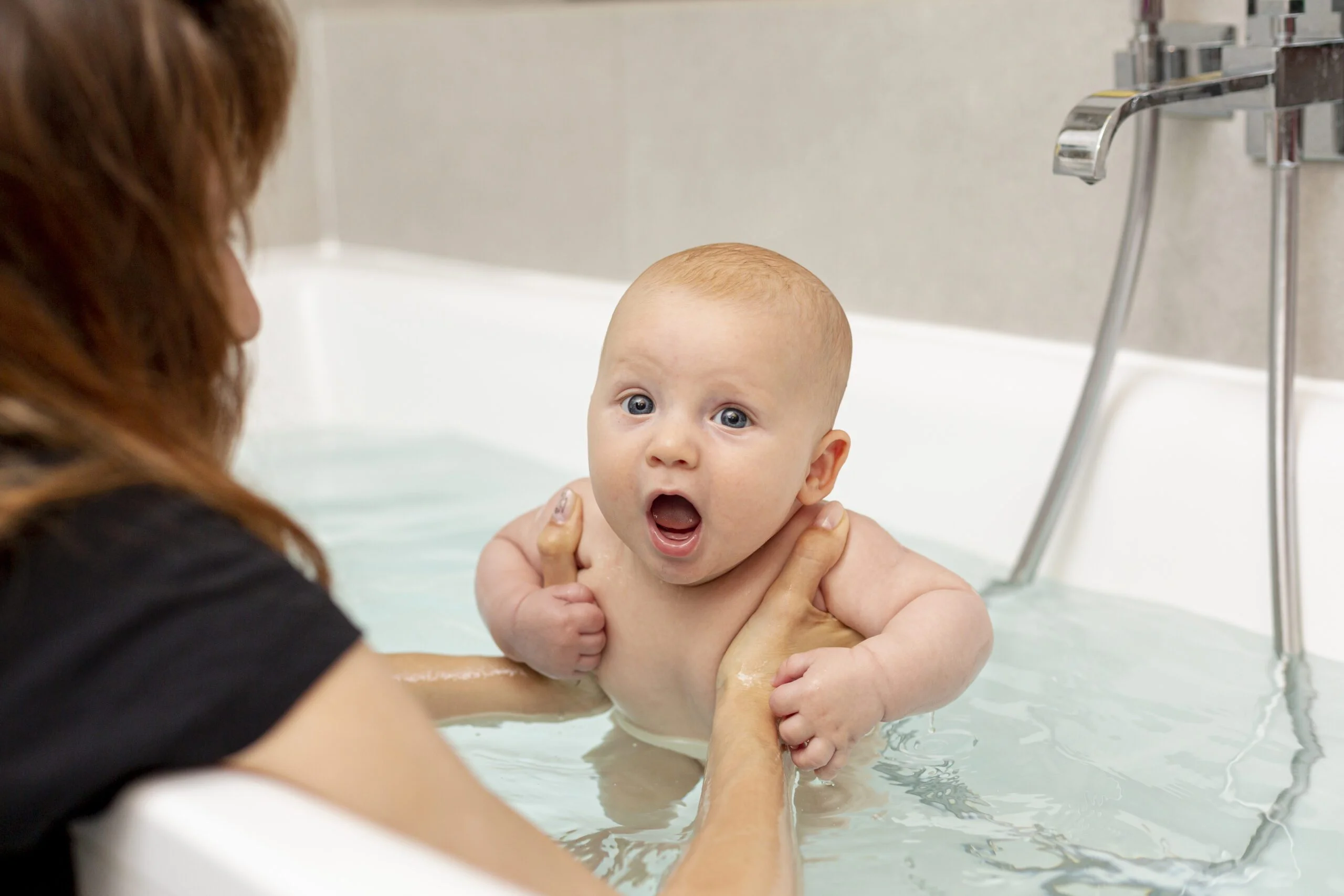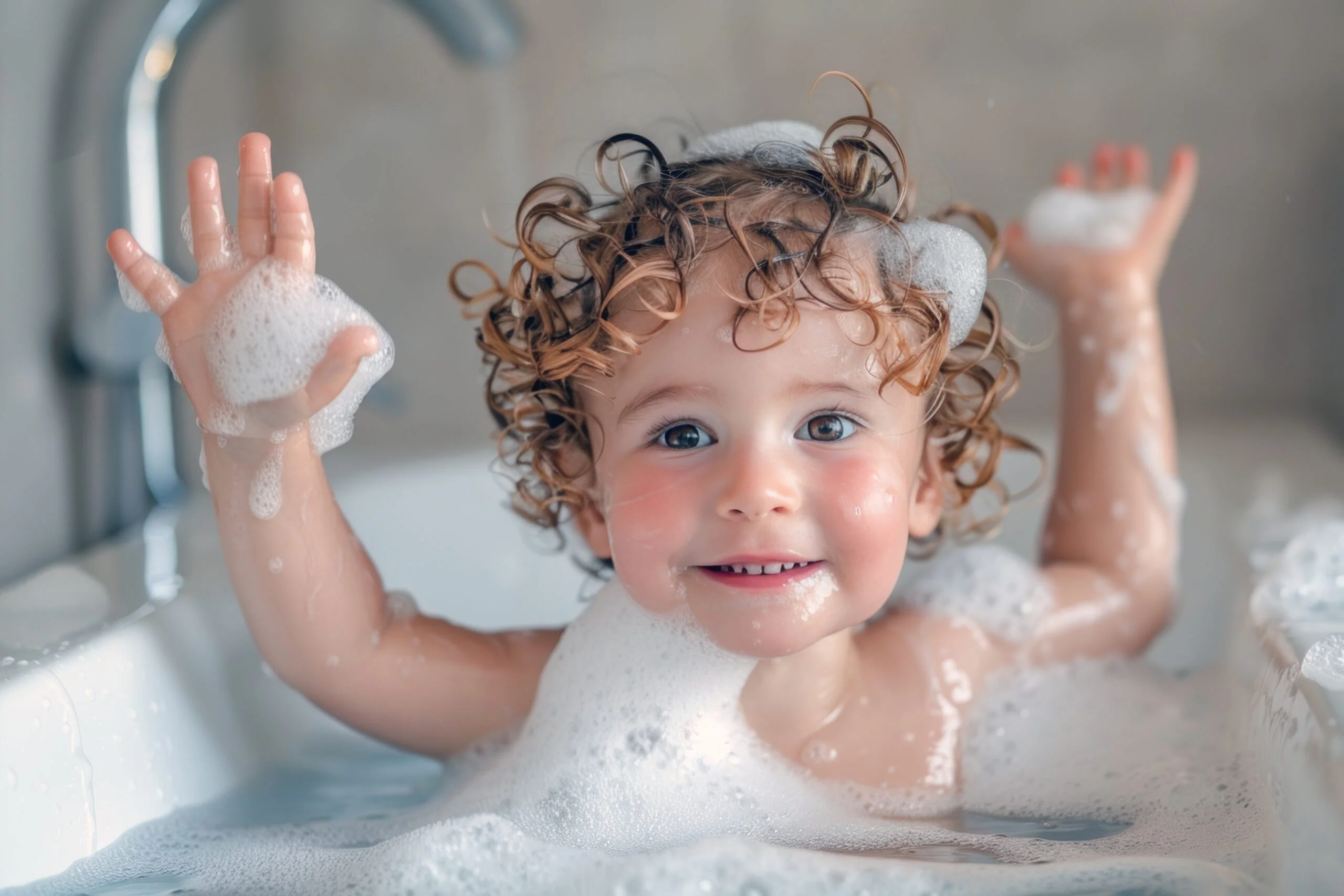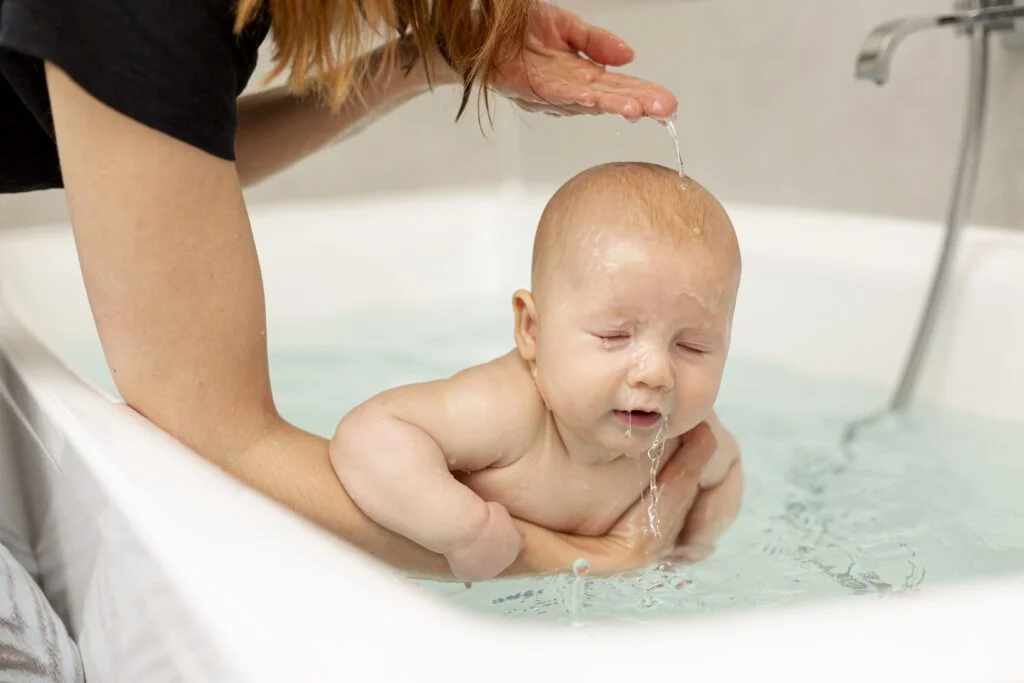Introduction
Bathing a newborn baby can be a delightful experience for both parents and babies. It not only helps keep your baby clean but also provides an opportunity for bonding. However, it can also be intimidating, especially for first-time parents. In this comprehensive guide, we’ll walk you through everything you need to know about bathing your newborn baby, step by step. But don’t worry, with a little preparation and these simple steps, you’ll be a bath-time pro in no time!

When to Start Bathing a Newborn Baby
Wait at least 24 hours: According to The World Health Organization (WHO), waiting at least 24 hours after birth before giving your baby their first bath. This allows the protective vernix, a waxy coating on their skin, to do its job of protecting them from germs and helping regulate their temperature.
Sponge baths until the umbilical cord falls off: Stick to sponge baths, until the umbilical cord stump falls off. Avoid getting the cord wet, as this can increase the risk of infection.
What You’ll Need to Prepare for the Bath
Baby bathtub or sink: A small baby bathtub or sink filled with warm water works well.
Washcloths: Soft, cotton washcloths are gentle on your baby’s delicate skin.
Mild, tear-free baby soap (optional): You don’t need soap for every bath, especially in the first few weeks. However, a gentle, tear-free soap can be used if needed.
Towels: Soft, absorbent towels are essential for drying your baby after the bath.
Thermometer: Use a baby bath thermometer to ensure the water temperature is safe.
Steps for a Safe and Happy Bath Time
#1 Gather everything you need: Before starting, ensure you have all the supplies within easy reach. This helps avoid leaving your baby unattended while you grab something.
#2 Prepare the bath: Choose a warm room where you can comfortably bathe your baby. Fill the bathtub or sink with warm water, around 37°C (98.6°F). Test the water temperature with your elbow or a bath thermometer to ensure it’s not too hot.
#3 Undress your baby: Gently undress your baby and keep them wrapped in a towel until you’re ready to lower them into the water.
#4 Support your baby: Cradle your baby securely in one arm, with their head resting on your forearm. Use your other hand to gently support their bottom.
#5 Lower your baby into the water: Slowly lower your baby into the water, feet first. Keep their head and neck above the water level.
#6 Start with the face: Use a clean, damp washcloth to gently wipe your baby’s face, avoiding the eyes.
#7 Wash the rest of the body: Use another clean washcloth to gently wash the rest of your baby’s body, including the neck, arms, legs, and diaper area.
#8 Use soap sparingly: If using soap, apply a small amount to the washcloth and lather it up before gently washing your baby. Rinse thoroughly with clean water.
#9 Clean baby’s body: Wet another washcloth with warm water and a small amount of baby soap. Gently wash your baby’s body, starting with the neck and working your way down to the feet. Pay special attention to the diaper area, armpits, and neck folds.
#10 Keep it quick: Aim for a short bath, typically 5-10 minutes, to avoid over-drying your baby’s skin.
#11 Clean baby’s hair: Wet your baby’s hair with warm water. Apply a small amount of baby shampoo and gently massage the scalp. Rinse thoroughly with warm water, ensuring no shampoo remains.
#12 Rinse and dry thoroughly: Rinse your baby with clean water, ensure all soap is removed. Pat your baby dries with a clean towel, paying attention to the creases to prevent irritation. Dress your baby in clean clothes and a fresh diaper.
#13 Dress your baby: Wrap your baby in a warm towel or put on their clothes and a fresh diaper.
Additional Tips to Bathe a Newborn Baby
Talk to your baby: Sing or talk to your baby throughout the bath to keep them calm and engaged
Be gentle: Always handle your baby with care and avoid any rough movements.
Never leave your baby unattended: Even for a few seconds, never leave your baby alone in the bath.
Enjoy the bonding time: Bath time can be a wonderful opportunity for bonding with your baby.

Safety Tips to Bathe a Newborn Baby
- Never leave your baby unattended in the bath, even for a moment.
- Support your baby’s head and neck with one hand while bathing.
- Keep the room warm to prevent your baby from getting cold.
- Every baby is different, so adjust the bath routine to your baby’s needs and preferences.
- If you have any concerns about bathing your baby, consult your pediatrician for advice.
Final Thoughts
With a little practice and patience, bath time can become a relaxing and enjoyable experience for you and your little one.
More to Read
- The best 6 baby bathtubs in 2024
- Getting the temperature just right: A guide to baby bath water
- Bath time: How often should you wash your little one
- Choosing the right baby bath products in 2 steps: The comprehensive guide
FAQ
When can I give my baby their first bath? The American Academy of Pediatrics recommends waiting at least 24 hours after birth for the first bath. This allows time for the umbilical cord stump to dry and fall off naturally.
How often should I bathe my newborn? Newborn babies don’t get dirty as easily as older children. 2-3 times a week is usually sufficient, and you can even skip baths some days if your baby seems content.
What do I need for a baby bath?
- A baby tub or sink.
- Warm water (around 100°F or 38°C).
- A soft washcloth.
- Gentle, tear-free baby shampoo (optional).
- A towel.
- A warm room.
How do I check the water temperature?
- Use a bath thermometer for the most accurate reading.
- Alternatively, dip your elbow into the water. If it feels comfortably warm, not hot, the temperature is likely safe.
How do I bathe my baby?
- Gather all your supplies beforehand.
- Undress your baby and keep them warm with a towel.
- Fill the tub with a few inches of warm water.
- Support your baby’s head and neck with one hand while gently washing them with the other.
- Use a damp washcloth to clean the face, ears, neck, and diaper area.
- If using shampoo, apply a small amount and gently massage the scalp. Rinse thoroughly.
- Wash the rest of the body with the washcloth or your hand.
- Rinse your baby with warm water.
- Wrap them in a warm towel and gently pat them dry.
What should I avoid during bath time?
- Never leave your baby unattended in the bath, even for a moment.
- Avoid using hot water, as it can burn your baby’s delicate skin.
- Don’t use harsh soaps or products.
- Be gentle and avoid scrubbing your baby’s skin.
- Don’t force your baby’s head underwater.
What if my baby cries during bath time? Some babies may not enjoy bath time at first. Be patient and try to make it a calm and relaxing experience. Talk to your baby, sing songs, and offer toys to distract them. If they continue to cry, it’s okay to take a break and try again later.
Do I need to clean the umbilical cord stump? No, it’s best to leave the umbilical cord stump alone. It will dry and fall off naturally within 1-2 weeks.
My baby has a cradle cap. How do I clean it? Cradle cap is a common, harmless condition that appears as oily, scaly patches on the scalp. You can gently massage the scalp with oil before bath time and then use a soft brush to loosen the scales during the bath.
When can I start using a bath seat? You can use a bath seat once your baby can sit up independently, usually around 6 months old.



Thanks for sharing. I read many of your blog posts, cool, your blog is very good. https://accounts.binance.com/pl/register-person?ref=YY80CKRN